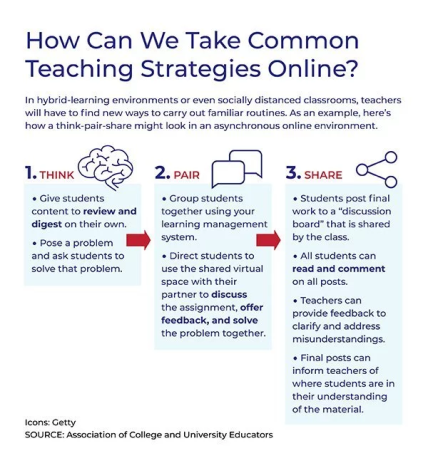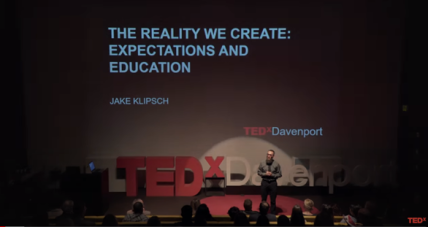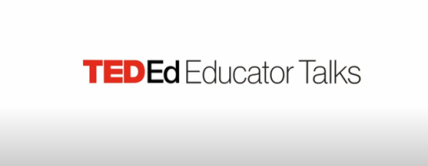
KEY 4 – Create a Community of Learners
If your classroom consists of students from diverse backgrounds, there is a high probability that many of those students are from "At – Potential" populations. One of the qualities of students from "At – Potential" populations is the tendency to operate from the vantage point of a survival mindset. One of the survival tactics employed by people who operate in a survival mindset is to rely upon their community. That being said, key #4 to creating a culturally responsive classroom system (CRCS) is to create a community of learners. The online instructor must understand that just because they do not view their students face-to-face, does not mean a community of learning cannot be established.
To embed key # 4 into your course design and instructional delivery, here are four overarching strategies into which you can plug any of the specific techniques and methods that you choose to adopt and activate.
Empower Everyone
A community of learners is one where all parties involved feel empowered to create and contribute to their own learning path, as well as the other members of the group. It is your job to make sure that each of your students need to know that they are important and that their opinions and contributions are just as meaningful to the educational growth of their peers as they are to their own growth and achievement. Creating empowered communities in the online classroom begins with instructors informing students of the supports, and accommodations available to help them be successful in the course. They should not be framed to appear as tools to help students earn an “A”, but instead as tools to facilitate mastery of the content to empower students for success in future learning instances the student will encounter (King, 2009).
Check out John Spencer’s article on his website, Empowering students in distance learning environments (2020).. At the bottom of the piece he shares seven practical ways that you can empower learners in your online classrooms. I believe that you will find these techniques helpful as you create your culturally responsive classroom system.
Spencer, J. (2020). Empowering students in distance learning environments. https://spencerauthor.com/empower-distance-learning/.
Create Routines That Focus on Mastery
An important part of this key is for the online instructor to build rituals and routines within the course that make keys 1, 2, and 3 the standard operating procedure or culture of the classroom. This sets the tone and solidifies the message that the course is focused on learning and not non-cognitive responsibilities of traditional college etiquette (i.e. APA formatting, due dates, and honoring the titles of instructors). Once it is understood that the focus in the course is on mastering the content, and students know that the instructor has a student-centered system of routines to successfully facilitate learning, the instructor can focus on ensuring equitable high expectations around course objectives are being maintained.
Establish High Expectations by Providing the Best Tools
In chapter 4 of my book, Why Some Seeds Don't Grow, I remind educators to accept only what they expect. To do so, "we must understand that expectations are relative to the thinking of the person who is selling them" (Miller, 2019, pae 51). Thus setting high expectations for diverse groups of students should not be based upon the educator's own hope, vision, faith, and belief of the self- efficacy their students possess to progress to a predetermined destination. In order for high expectations to be calibrated correctly, they must align to the needs, potential, and aspirations of each individual student being served. It is important to create a community of learners in which we can thoroughly observe our students to determine if the expectations we set are reasonable or beyond (Miller, 2019).
There are numerous techniques and methods that instructors can employ to assist the cognitive side of things that applied directly to course content. For instance, using exemplary examples of assignments as a means of communicating clear expectations allows students to see specifically what is required for them to know, understand, and be able to do.
However, I am from the school of thought that a more powerful way to tailor and establish high expectations in classrooms that serve students from diverse backgrounds is for instructors to make it plain to their students how much they believe in the students’ ability to master the content. High expectations are individually tailored when instructors take time to positively reinforce each student's accomplishments in real-time as they occur in the life of the classroom. When students are not moving in the right direction, instructors should praise their effort, but redirect their thinking and have them re-submit the assignment, without penalty, so they authentically produce and present their best work. This creates an environment in which there is genuine respect for students and a belief in their capability to excel as well as a very clear message that the instructor will only accept what they expect. (The Education Alliance Brown University, n.d.).
This TEDxTalk is a little technical,but speaks directly to how the perceived expectations of our students affect the expectations they have of themselves.
TEDx Talks (2018, Mach 22). The reality we create: Expectations and education. Jake Klipsch TEDxDavenport. YouTube. https://www.youtube.com/watch?v=avbkJRLv1cA
Speak life to Strengths and Possibility to Weaknesses
Often when serving at-potential students, educators do not like their students or are from different socioeconomic backgrounds tend to have a saviourism rather than an allyism approach to instruction. Empathizing with the struggles of their students' realities, educators operating in a saviourism mentality tend to overcompensate for the students' feelings and thus become unintentional diminishers. In essence, because they are aware that many of their students are carrying an enormous weight of life issues outside of the classroom, these educators do not want to add any more to that load with things that pertain to issues inside the classroom. Although this is a noble gesture, it causes a deceptive spotlight on the students true strengths and weaknesses, academic or otherwise.
You are the gateway
It is important to understand that you are the gateway that leads to creating students were competitive beyond their experience with you such that they can become truly and productive members of society, or simply creating students who are successful in your classroom but struggle beyond the culture that you have created.
Thus, it is important that you create a healthy and results proven cycle of continuous improvement within your community of learners. The easiest way to do that is to teach to mastery. I had the opportunity to serve under Dr. Craig Swenson, former president of Ashford University, always said, "What if it was just about learning?" Following that premise, it is important to be upfront, clear, and in no uncertain terms make students aware of their weaknesses and opportunities for growth by pointing out any performance data you have collected and provide them with high-quality formative feedback. In order for them to grow, they must know the what, where, why, and how behind the things that they need to correct. But don't stop there. Once those areas of opportunity are exposed, emphasized, and explained to students, then give them the opportunity to respond to your formative feedback and correct, redo, and resubmit projects. This provides an opportunity to demonstrate that they have mastered the content that you are teaching. In essence, identify the issue, expose it, provide formative feedback, and tell the students to back up and try again.
This TEDx Talk speaks directly to the students in the K-12 system, but the principles in the talk also apply to work being done in the Higher Education arena.
TEDx Talks (2019, November 21). We owe all students high expectations. Shemeka Millner-Williams. YouTube. https://www.youtube.com/watch?v=Iw1O1_ySKAs.
References for this Lesson
4 Tips to Make an Online Course More Welcoming
5 Ways to empower students: Giving them a voice in their own education.
Empowering students in distance learning environments
Facilitation Vs teaching: 20 differences we must know!
Microaggressions in the Classroom



